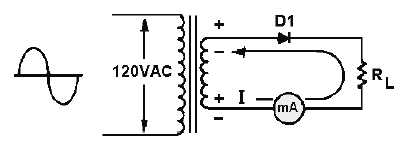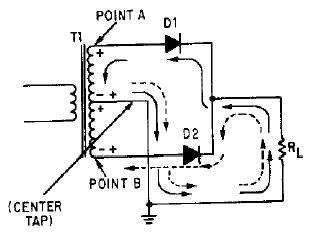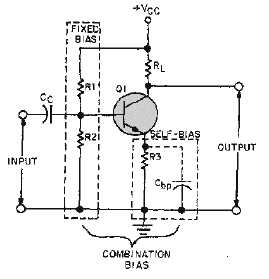Question
Explain the term RECTIFIER, HALF-WAVE
RECTIFIER, FULL-WAVE RECTIFIER, BRIDGE RECTIFIER, Amplification
Thermonic Emission:
The RECTIFIER is the section of
the power supply that contains the secondary windings of the power transformer
and the rectifier circuit. The rectifier uses the ability of a diode to conduct
during one half cycle of ac to convert ac to dc.
HALF-WAVE RECTIFIERS give an
output on only one half cycle of the input ac. For this reason, the pulses of
dc are separated by a period of one half cycle of zero potential voltage.

FULL-WAVE RECTIFIERS conduct on
both halves of the input ac cycles. As a result, the dc pulses are not
separated from each other. A characteristic of full-wave rectifiers is the use
of a center-tapped, high-voltage secondary.

Because of the center tap, the output of the rectifier is limited to
one-half of the input voltage of the high-voltage secondary.
BRIDGE RECTIFIERS are full-wave
rectifiers that do not use a center-tapped,
high-voltage secondary. Because of this, their dc output voltage is equal to
the input voltage from the high-voltage secondary of the power transformer.
Bridge rectifiers use four diodes connected in a bridge network. Diodes conduct
in diagonal pairs to give a full-wave pulsating dc output.

Amplification
In the descriptions of npn and pnp
transistors, the same sort of circuit was used in each with small signal power
from a side circuit B controlling the larger power in a circuit A. The
transistor enables a signal, too weak in itself to be of direct use, to control
a larger power source (battery A in the examples). The control by a small
available power over a large usable power is called power gain or
amplification. Transistors can be connected in different ways and they can be
used for various purposes, including switching.
AMPLIFICATION is the process of
increasing the strength of a signal.
An AMPLIFIER is the device that
provides amplification without appreciably altering the original signal.
The BASIC TRANSISTOR AMPLIFIER
amplifies by producing a large change in collector current for a small change
in base current. This action results in voltage amplification because the load
resistor placed in series with the collector reacts to these large changes in
collector current which, in turn, results in large variations in the output
voltage.

The three types of BIAS used to
properly bias a transistor are base-current bias (fixed bias), self-bias, and
combination bias. Combination bias is the one most widely used because it
improves circuit stability and at the same time overcomes some of the
disadvantages of base-current bias and self-bias.

Thermonic
Emission: The process of electrons emission from a metal surface by supplying
thermal energy to it is known as thermonic emission.
At ordinary temperatures, the energy possessed by free electrons in the metal
is inadequate, to cause them to escape from the surface. When heat is applied
to the metal, some of the heat energy is converted into kinetic energy causing accelarated motion of free electrons, which acquire
additional energy equal to the work function of the metal. Consequently they
overcome the restraining surface barsier and leave
the metal surface.